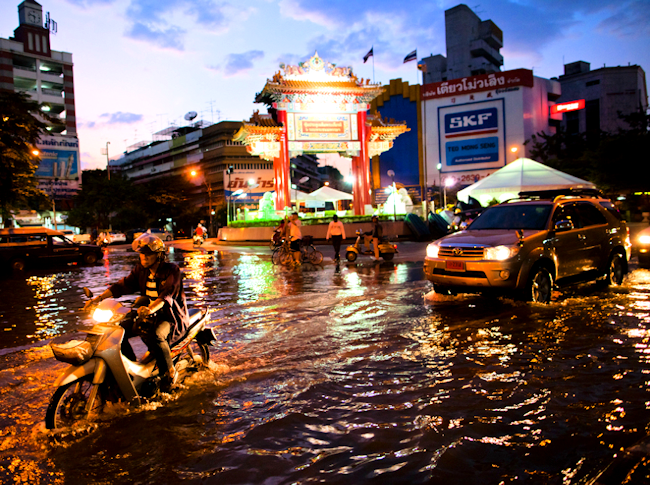Fears of a repetition of the 2011 epic flood will haunt city residents in the coming days as heavy rain leads to massive floods in the northern part of the capital and adjacent areas. While the current conditions do not match 2011’s huge proportions, the reaction of City Hall does not inspire much hope. The Bangkok Metropolitan Administration (BMA), regardless of who is elected or appointed governor, has reacted to the flooding in the same manner that is did in past years.
It needs to be said that Bangkok governor Chadchart Sittipunt has made preparations — having clogged sewers drained, removing debris from canals, laying sandbag walls along flood-risk areas and making sure that water draining systems work properly. Yet it is not the time to appraise the Bangkok Governor’s performance, as the problems are much larger than one individual.
The problem stems from an imbalanced ecology in the city, mostly a lack of natural flood-catchment spaces locally called kaem ling, or monkey cheeks, to help drain flood water as in the past.
The BMA and the central government have invested money in technology: water tunnels, water pumps, flood gates and data technology to deal with the city’s flooding issues. Of course, technology and concrete infrastructure are vital to control floods and direct flows but the flood situation this week again proved these measures have been insufficent.
Since 2011, the BMA has tried to create additional 30 water-catchment projects in flood-prone areas in the western and eastern parts of the city to compensate for the vast low-lying flood plains which have been filled up to give way to property development.
Over the past decade, the BMA has managed to create over 25 projects mostly in the western area of Thon Buri and some in flood-prone areas in the eastern part of Bangkok.
Yet, the efforts to reclaim or purchase land came to a halt over the last five years.
The BMA reportedly backpedalled or was not proactive enough in renting or purchasing land from the private sector to use for flood-retention purposes.
Flood experts such as Seree Supratid, director of the Climate Change and Disaster Centre of Rangsit University, have proposed to invest more in finding small, vacant land plots to serve as natural flood catchment areas. This idea is not very popular with the government
The flooding of the past decade shows that our existing efforts of relying on technology and the use of concrete are not enough.
Policymakers can’t keep doing exactly the same thing and expecting there to be a different outcome.
Source: Bangkok Post



